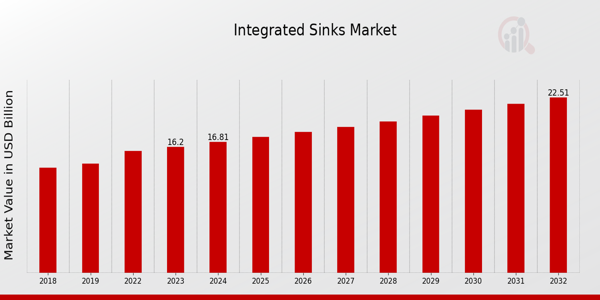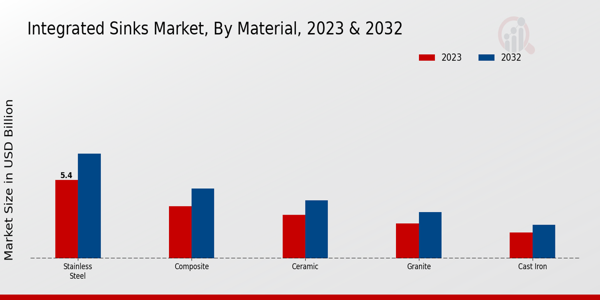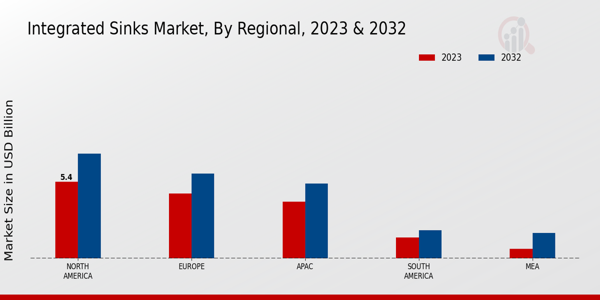Global Integrated Sinks Market Overview
The Integrated Sinks Market Size was estimated at 17.43 (USD Billion) in 2024.The Integrated Sinks Industry is expected to grow from 18.08(USD Billion) in 2025 to 25.12 (USD Billion) by 2034. The Integrated Sinks Market CAGR (growth rate) is expected to be around 3.7% during the forecast period (2025 - 2034).
Key Integrated Sinks Market Trends Highlighted
The Integrated Sinks Market is experiencing significant growth driven by increasing consumer demand for durable and aesthetically pleasing kitchen and bathroom solutions. Rising home renovation activities and the trend toward modern living spaces are key market drivers. Many consumers prefer integrated sinks for their seamless design, which not only enhances functionality but also adds to the visual appeal of their kitchens and bathrooms. Additionally, the growing awareness around hygiene and cleanliness is propelling the demand for integrated sink designs that reduce the chances of dirt accumulation. Opportunities in this market are expanding as manufacturers explore innovative materials and designs that cater to diverse consumer preferences.Sustainable materials are rapidly gaining popularity among consumers and businesses due to the awareness of the environment they create. In addition, the increase in e-commerce is enabling brands to promote more integrated sink options and reach a wider customer base. There is also a tendency for larger manufacturers to focus on more personalized products since the customer's expectations include matching the product with the customers' aesthetic. In today's scenario, the latest happenings demonstrate a clear departure from traditional integration to smart homes as sinks with technology integration are in demand. Integrated sensors, touchless controls, and automatic temperature controls are increasingly common.
These trends are interconnected with each other since the current tendencies of modern life and convenience affect the consumer regardless of their age. The Integrated Sinks Market appears to be undergoing a transition with key trends centered on functional, adaptive and technological advancement and, therefore, continues to have strong growth opportunities.

Source: Primary Research, Secondary Research, MRFR Database and Analyst Review
Integrated Sinks Market Drivers
Growing Demand for Aesthetic and Functional Kitchen Designs
One of the primary drivers of the Integrated Sinks Market Industry is the increasing consumer preference for aesthetic and functional kitchen designs. Homeowners are increasingly focusing on the design and layout of their kitchens, which is not just a space for cooking but also a social hub for family gatherings and entertaining guests. The trend towards open-concept floor plans has made the kitchen a prominent feature in modern homes, leading to a surge in demand for integrated sinks that blend seamlessly with countertops and cabinetry.Integrated sinks offer a sleek, streamlined appearance, which appeals to consumers looking for both functionality and style. This aesthetic appeal is particularly crucial in high-end residential markets, where consumers are willing to invest in premium materials and innovative designs. Furthermore, the integration of technology into kitchen appliances is also driving demand as consumers look for products that enhance convenience and efficiency.This trend of marrying style with efficiency has rendered integrated sinks a desirable choice, thereby propelling growth in the Integrated Sinks Market. As the design preferences of homeowners evolve, manufacturers and retailers are responding by offering a wide variety of integrated sink options that combine durability with innovative design, further supporting market expansion.
Rising Renovation and Remodeling Activities
Another significant driver for the Integrated Sinks Market Industry is the rise in home renovation and remodeling activities. As homeowners increasingly invest in upgrading their living spaces, kitchens are often a primary focus of these renovations. Integrated sinks are favored during such upgrades due to their modern appeal and enhanced functionality, enabling maximum use of kitchen space. This trend is fueled by growing disposable incomes and the desire for personalized living environments, positioning integrated sinks as an attractive option for those looking to enhance their kitchens.
Sustainability and Eco-friendly Product Preferences
The growing emphasis on sustainability and eco-friendly products significantly impacts the Integrated Sinks Market Industry. Consumers are becoming more environmentally conscious and are opting for integrated sinks made from sustainable materials. This trend encourages manufacturers to innovate and offer products designed with sustainability in mind, tapping into a wider market segment concerned with environmental responsibility.
Integrated Sinks Market Segment Insights
Integrated Sinks Market Material Insights
The Integrated Sinks Market, focusing on the Material segment, reveals robust growth dynamics with a market valuation of 16.2 billion USD in 2023, projected to increase significantly to 22.5 billion USD by 2032. This growth trajectory highlights a steady rise fueled by increasing consumer demand for quality kitchen and bathroom fixtures, alongside heightened awareness of durable materials. Within the material categorization, Stainless Steel stands out prominently, commanding a valuation of 5.4 billion USD in 2023 and is forecasted to grow to 7.2 billion USD by 2032.Its properties of resistance to corrosion and ease of maintenance make it a favored choice among consumers and builders alike, contributing to its majority holding in the market. Composite sinks, with a valuation of 3.6 billion USD in 2023, are also on a positive path, expected to reach 4.8 billion USD by 2032. The versatility and aesthetic options of composite materials appeal to a wide range of consumers, making them a significant contender in the market. Meanwhile, the Ceramic segment, valued at 3.0 billion USD in 2023, is projected to rise to 4.0 billion USD by 2032, resonating well in traditional settings for its classic look and ease of cleaning.Granite sinks were valued at 2.4 billion USD in 2023 and are anticipated to reach 3.2 billion USD by 2032, appreciated for their durability and elegance, appealing to high-end market segments. Lastly, the Cast Iron segment, with a valuation of 1.8 billion USD in 2023, is predicted to advance to 2.3 billion USD by 2032; while it holds the smallest share among the other materials, it remains notable for its heat retention and traditional appeal in rustic kitchen designs. Overall, the Integrated Sinks Market segmentation by material showcases a diverse landscape driven by consumer preferences, functional attributes, and aesthetic considerations, underscoring the importance of each material type in meeting modern design and usability needs.

Source: Primary Research, Secondary Research, MRFR Database and Analyst Review
Integrated Sinks Market Type Insights
The Integrated Sinks Market, valued at 16.2 USD Billion in 2023, showcases a diverse range of types, each catering to different consumer needs and preferences. Key types in this market include Single Bowl, Double Bowl, Triple Bowl, Farmhouse, and Undermount sinks, which play a significant role in residential and commercial applications. The Single Bowl sinks are often favored for their simplicity and space-saving design, while Double Bowl models provide versatility for multitasking, which appeals to busy households. The growing trend towards aesthetics has propelled Farmhouse sinks into prominence, appealing to consumers looking for both functionality and style.Undermount sinks have gained traction for their seamless integration with countertops, making cleaning easier and enhancing kitchen aesthetics. With the market witnessing a steady demand driven by factors such as urbanization and home renovation trends, understanding the Integrated Sinks Market segmentation is critical for stakeholders aiming to leverage market growth opportunities. As consumer preferences continue to evolve, there is a clear inclination towards innovative designs and materials in the integrated sink industry, reflecting changing lifestyles and preferences.
Integrated Sinks Market Installation Type Insights
In 2023, the Integrated Sinks Market demonstrated considerable activity within the Installation Type segment, reflecting a growing preference for various designs among consumers. The market is projected to experience significant growth, valued at 16.2 billion USD. The segment includes several installation types, such as Top Mount, Undermount, Integrated, and Wall Mounted, each catering to different consumer needs and preferences. Top Mount sinks offer easy installation and have gained popularity for their affordability and versatility, while Undermount sinks are favored for their seamless appearance and ease of cleaning.Integrated sinks, which combine the sink and countertop into one unit, are increasingly sought after due to their modern aesthetic and functionality. Wall Mounted sinks are often favored in compact spaces, providing an elegant and minimalist look along with practicality. With the ongoing trend towards innovative designs and functionality, the Integrated Sinks Market continues to evolve, driven by consumer demand for stylish and efficient solutions in kitchen and bathroom spaces. As market growth progresses, these installation types are expected to adapt to changing preferences and trends, indicating a dynamic landscape for the Integrated Sinks Market industry.
Integrated Sinks Market End-Use Insights
The Integrated Sinks Market, valued at 16.2 USD Billion in 2023, is witnessing notable growth across various end-use applications, including Residential, Commercial, and Industrial sectors. Among these, the Residential segment plays a crucial role, with increasing consumer preference for aesthetic and functional designs driving demand. The Commercial segment also significantly contributes to market growth, fueled by the expansion of restaurants, hotels, and other service-oriented businesses that prioritize durable, attractive sinks to enhance customer experience.Meanwhile, the Industrial segment is characterized by its focus on heavy-duty solutions that can withstand rigorous usage in manufacturing and processing environments. The diverse requirements across these end-use segments underscore the importance of tailored solutions that cater to specific consumer needs and preferences. With the Integrated Sinks Market poised for steady growth, the integration of innovative materials and designs is likely to create additional opportunities for expansion, making it essential for industry players to adapt to evolving market trends and consumer demands.
Integrated Sinks Market Regional Insights
The Integrated Sinks Market revenue shows a significant regional distribution, with North America leading the segment valued at 5.4 USD Billion in 2023 and projected to grow to 7.4 USD Billion by 2032, reflecting a strong demand driven by residential and commercial construction activities. Europe follows closely, valued at 4.6 USD Billion in 2023 and expected to reach 6.0 USD Billion by 2032, benefitting from sustainable design trends. The APAC region is also noteworthy, with a valuation of 4.0 USD Billion in 2023, anticipated to increase to 5.3 USD Billion by 2032, highlighting the rapid urbanization and rising disposable income in countries like India and China.South America, though smaller, grew from 1.5 USD Billion in 2023 to 2.0 USD Billion by 2032, indicating emerging market potential. Lastly, the MEA segment, valued at 0.7 USD Billion in 2023 and increasing to 1.8 USD Billion by 2032, showcases a growing interest in modernizing infrastructure amidst ongoing economic developments. Overall, the Integrated Sinks Market segmentation reflects diverse growth opportunities across different regions driven by factors such as urban development, sustainability, and economic growth.

Source: Primary Research, Secondary Research, MRFR Database and Analyst Review
Integrated Sinks Market Key Players and Competitive Insights
The Integrated Sinks Market is characterized by increasing competition driven by innovation, evolving consumer preferences, and a growing focus on sustainability. As more households integrate advanced sink solutions into their kitchens and bathrooms, manufacturers are striving to differentiate their offerings through design, functionality, and durability. The market encompasses various players who are utilizing a blend of marketing strategies, product enhancements, and partnerships to maintain their competitive edge. Innovative technologies, such as integrated sink systems that combine sinks with faucets and accessories, are becoming more prevalent, indicating a trend towards multifunctional units that cater to modern consumer demands. Additionally, competition is intensifying as brands aim to enhance aesthetics while maximizing utility, thereby appealing to a broader audience.Moen has established a strong presence in the Integrated Sinks Market, driven by its commitment to quality and innovation. The company is well-regarded for its diverse product range, which includes integrated sink solutions designed for both functionality and aesthetic appeal. Moen's designs often feature contemporary styles that resonate with modern consumers, ensuring they fit seamlessly into various kitchen and bathroom settings. The company's strengths lie in its robust research and development efforts, which focus on introducing new materials and technologies that enhance user experience.
Additionally, Moen is recognized for excellent customer service and comprehensive warranty offerings, which further solidify its reputation in the marketplace. The brand's commitment to sustainability through environmentally friendly materials and production processes also plays a significant role in its appeal to eco-conscious consumers.Kohler similarly maintains a significant footprint in the Integrated Sinks Market, renowned for combining artistic design with superior functionality. The company has a reputation for luxurious design elements and innovative products that cater to high-end consumers seeking premium sink solutions. Kohler's integrated sinks often incorporate cutting-edge technology, ensuring ease of use and efficiency in everyday tasks. With a keen emphasis on craftsmanship, Kohler consistently delivers products that reflect both style and durability. The brand's strategic partnerships with designers and architects further enhance its visibility in the market, positioning it as a leader in design-oriented solutions. Additionally, Kohler is dedicated to sustainability practices, regularly introducing eco-friendly products that resonate with environmentally conscious consumers, reinforcing its market position and ability to cater to a growing demand for sustainable home solutions.
Key Companies in the Integrated Sinks Market Include
- Moen
- Kohler
- Villeroy and Boch
- Caesarstone
- Panda
- Franke
- Roca
- Elkay
- Nivito
- Grohe
- Swanstone
- Blanco
- Teka
- American Standard
- Häfele
Integrated Sinks Market Industry Developments
Recent developments in the Integrated Sinks Market indicate a rising interest in sustainability and innovative designs among key players such as Moen, Kohler, Villeroy and Boch, and Caesarstone. Companies are focusing on enhancing product functionalities while maintaining aesthetic appeal, driven by consumer demand for eco-friendly materials and advanced features. Notably, Moen has launched new product lines featuring smart technology integration, making an impressive mark in the market. Additionally, during the last quarter, several companies, including Roca and Elkay, reported growth in market valuation, attributed to an increase in renovation spending and a shift toward integrated sink solutions in kitchen and bathroom setups. In terms of mergers and acquisitions, there have been no major publicly known transactions involving companies like Franke, Grohe, or Blanco recently, although strategic partnerships aimed at boosting market presence have been observed. Overall, the competitive landscape reflects a robust commitment to innovation, quality, and sustainability, signaling positive trends for the future of the Integrated Sinks Market.
- Integrated Sinks Market Segmentation Insights
- Integrated Sinks Market Material Outlook
- Stainless Steel
- Composite
- Ceramic
- Granite
- Cast Iron
- Integrated Sinks Market Type Outlook
- Single Bowl
- Double Bowl
- Triple Bowl
- Farmhouse
- Undermount
- Integrated Sinks Market Installation Type Outlook
- Top Mount
- Undermount
- Integrated
- Wall Mounted
- Integrated Sinks Market End-Use Outlook
- Residential
- Commercial
- Industrial
| Report Attribute/Metric |
Details |
| Market Size 2024 |
17.43(USD Billion) |
| Market Size 2025 |
18.08(USD Billion) |
| Market Size 2034 |
25.12(USD Billion) |
| Compound Annual Growth Rate (CAGR) |
3.7% (2025 - 2034) |
| Report Coverage |
Revenue Forecast, Competitive Landscape, Growth Factors, and Trends |
| Base Year |
2024 |
| Market Forecast Period |
2025 - 2034 |
| Historical Data |
2020 - 2024 |
| Market Forecast Units |
USD Billion |
| Key Companies Profiled |
Moen, Kohler, Villeroy and Boch, Caesarstone, Panda, Franke, Roca, Elkay, Nivito, Grohe, Swanstone, Blanco, Teka, American Standard, Häfele |
| Segments Covered |
Material, Type, Installation Type, End Use, Regional |
| Key Market Opportunities |
Sustainability-focused design innovations, Smart sink integration technology, Rising demand in residential sectors, Growth in hospitality industry installations, Expansion in developing markets |
| Key Market Dynamics |
Growing residential construction demand, Increasing popularity of multifunctional products, Shift towards sustainable materials, Rising need for space optimization, Technological advancements in design |
| Countries Covered |
North America, Europe, APAC, South America, MEA |
Frequently Asked Questions (FAQ) :
The Integrated Sinks Market is expected to be valued at 25.12 USD Billion by 2034.
The expected CAGR for the Integrated Sinks Market from 2025 to 2034 is 3.7%.
North America is projected to have the largest market size, valued at 7.4 USD Billion in 2032.
The market size for Stainless Steel integrated sinks is projected to reach 7.2 USD Billion in 2032.
Major players include Moen, Kohler, Villeroy Boch, and Franke, among others.
The market size for Composite integrated sinks is projected to reach 4.8 USD Billion in 2032.
The market growth opportunities lie in increasing demand for innovative and sustainable sink materials.
The APAC region is projected to have a market size of 5.3 USD Billion by 2032.
The expected market size for Ceramic integrated sinks is projected to reach 4.0 USD Billion by 2032.
Key trends include the rising popularity of eco-friendly materials and designs suited for modern kitchens.

















